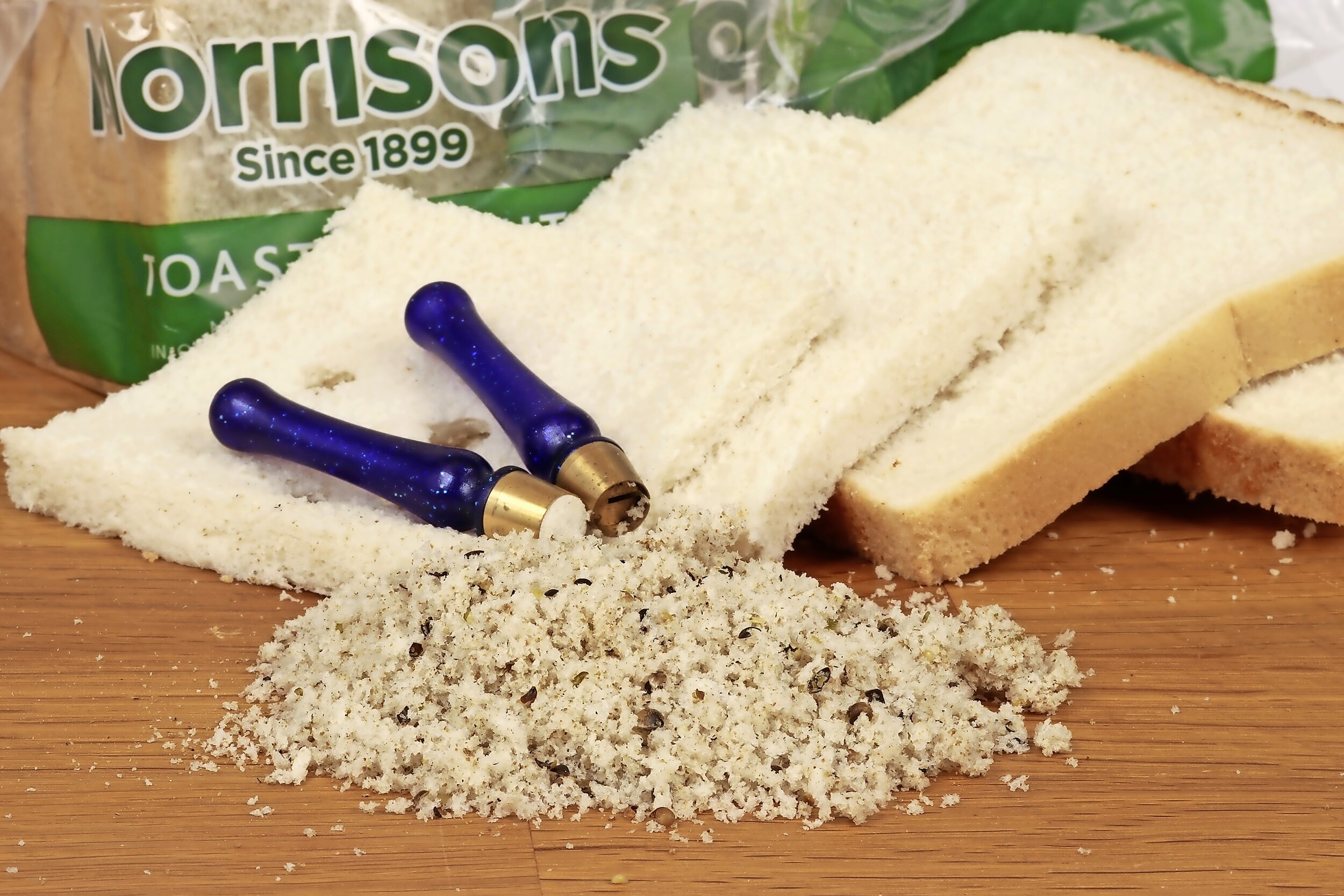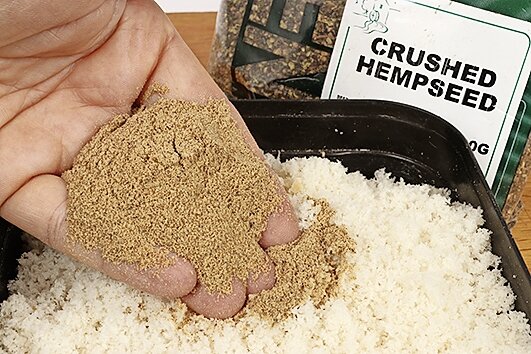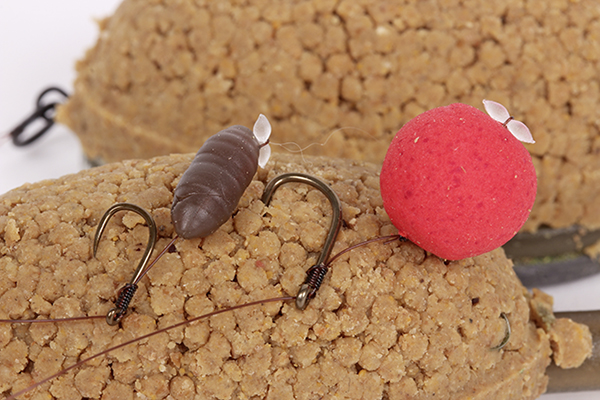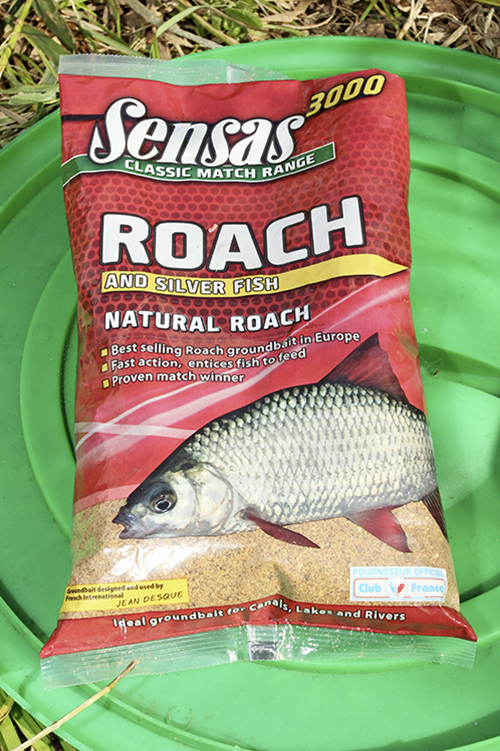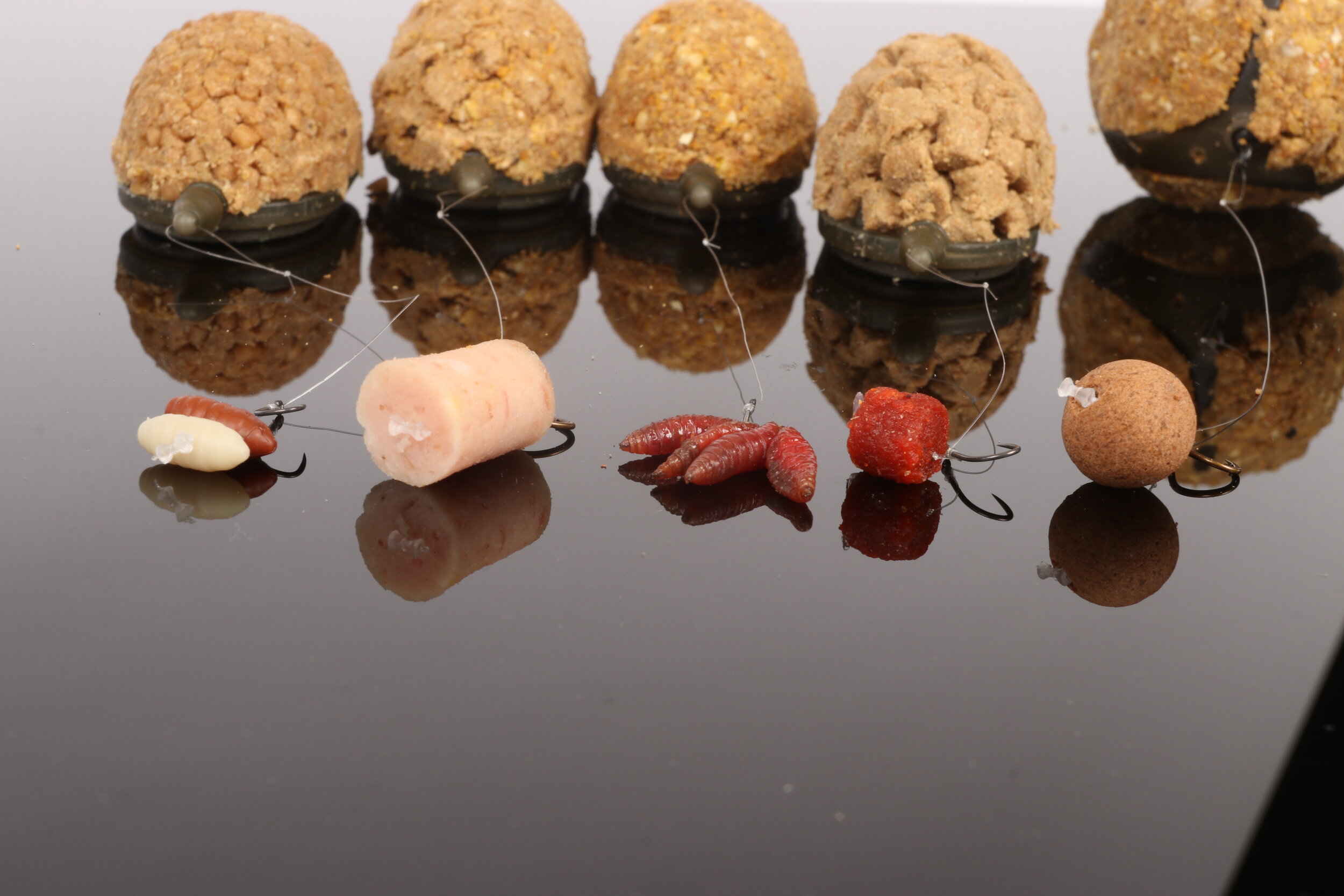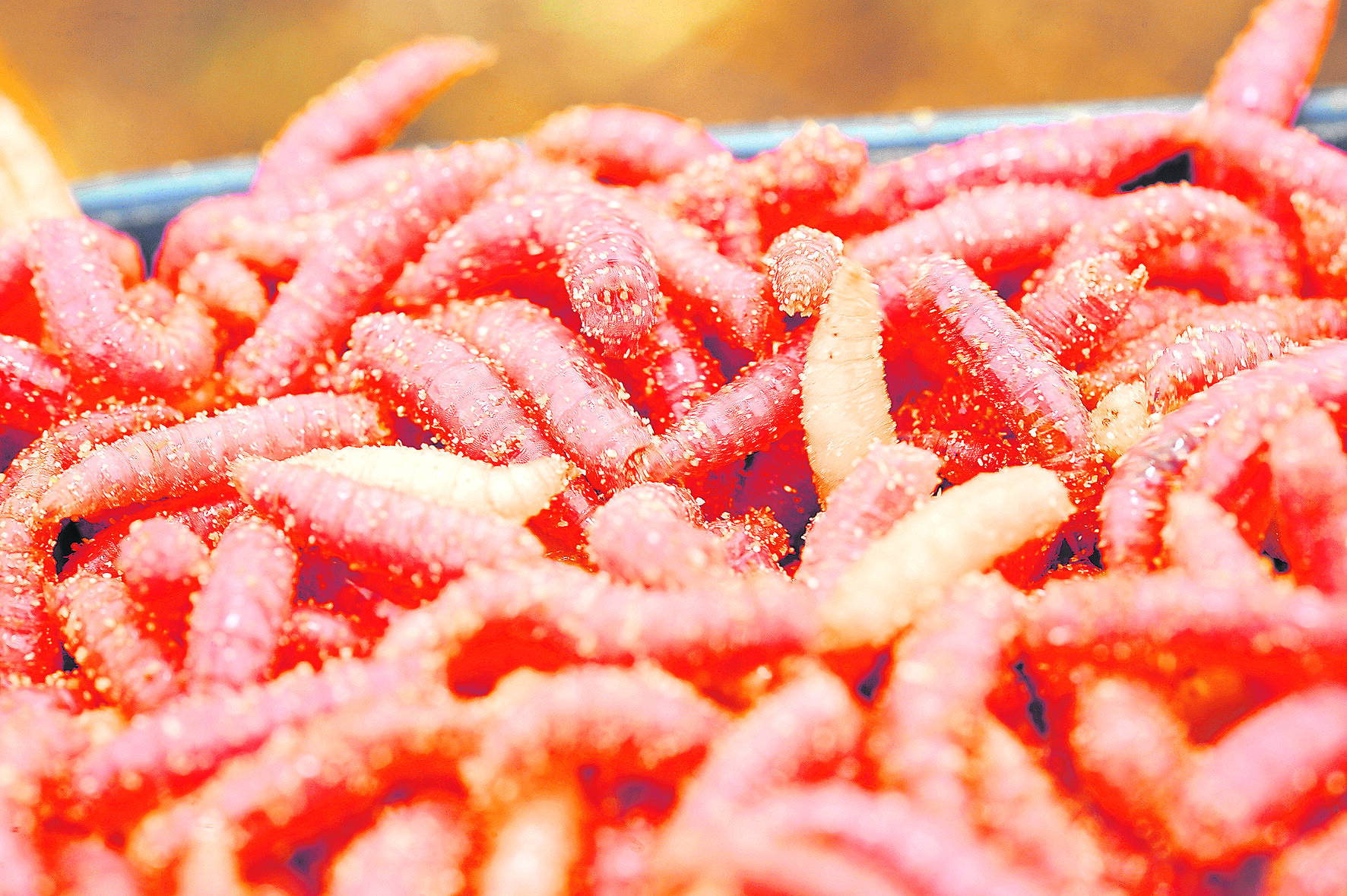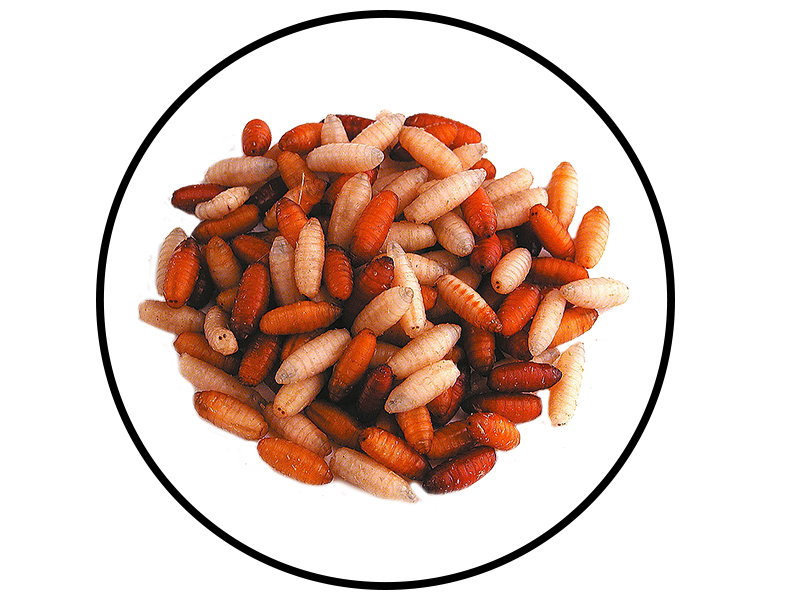5 Tips On Groundbait For Roach
No roach angler worth their salt would be without groundbait at this time of year – here’s how to use it!
ADD FREEBIES
GROUNDBAIT alone is not enough to keep the fish in the peg and, because you want them to eat the hookbait, you have to add the same into the feed. For roach, that’s dead pinkies, dead maggots and casters – the three most common hookbaits. In the opening balls of feed, add very few free offerings. Once these are fed, pop in two more balls that are rich in feed (packed with casters and pinkies) to create a focal point in the swim to fish over. On a hard day that may be just a sprinkling, but on a mild day with colour in the water, pack each ball with feed. Dead pinkies are great because they are soft, visible and small enough to get fish grubbing about.
Add freebies to your groundbait
TRY USING LEAM
YOU can add leam to normal groundbait, which will make the mix behave very differently. Leam used to be seen as something that was only used with bloodworm and joker, but when this fine, powdered clay is added to over-wetted groundbait it achieves two things. First, it adds some weight and second, it breaks the ball down quicker on the bottom. Depending on how much leam you add, you can make a ball split almost immediately, leaving a lingering cloud, which can be dynamite in shallow, clearish water. Heavy leams are also available that will combat strong flows in deep water, getting a ball to the bottom in seconds.
Leam will make the mix behave very differently
BALL IT... THEN CUP
THE best way to get a lot of groundbait into the peg quickly is to throw in several large balls, known as ‘balling in’. You’ll see this a lot on big, deep natural venues where small fish are the target. A massive hit kicks the peg off quickly, but you need to decide on how many balls to throw in. There’s no point scrimping on numbers, so eight or 10 large balls can go in over an area of a square metre. A pole cup then comes into play. The opening hit gets fish into the general area, but you want them to move and concentrate on the spot where your rig is. Two or three more balls go in with the pot in the same place, but these hold more particles.
A pole cup is a great way to feed throughout the session
RIDDLE YOUR MIX
ASIDE from removing any large lumps of part-mixed groundbait, riddling also adds air into a mix, which makes it sink quickly and break up fast. Without being put through a riddle, the groundbait can be too stodgy and struggle to come apart. When you’ve riddled the mix, you need to decide what to do with the bigger particles that you’ll have left over. These can be thrown away if the fishing is likely to be hard, but on more prolific days they can be pushed by hand through the riddle to put some bigger bits and bobs into the mix.
Riddling your groundbait has many advantages
FEED IT LOOSE
THERE are times when cupping in groundbait loose is better than balling it in, and this is normally in very shallow water of 3ft or less. A loose mix also gets things underway much faster because the groundbait is already broken down and can work its magic straight away. It’s important that the mix is wet, so it has the weight to get down quickly and stay put on the bottom without any danger of drifting off, especially in flowing water. Loose groundbait also works on canals and drains with steep marginal slopes under the water – a hard ball may roll down this slope, away from where you’re fishing. Loose groundbait will form a carpet just where you want it, and never move!
Sometimes groundbait is best fed loose
"It has to be bread for river roach" with Dr Paul Garner
Roach are staging a substantial comeback. Whether from the tremendous work of the Avon Roach Project, or natural recruitment on other rivers, big roach are out there for those willing to look for them.
Very often the first clues are fish caught by accident, often by chub or barbel anglers, using heavy gear. Be quick to follow up on these leads and you might just strike the silver fish mother lode.
WORLDS APART
Quite why river roach should be willing to feed on a much wider range of baits than their stillwater cousins, especially in the winter, can only be guessed at. I think it is probably because in stillwaters small invertebrates make up virtually all of the fish’s diet. This means that they become fixated on small baits, such as maggots.
In rivers, big roach will have a wider natural diet, and so are not as choosy. Heavily-fished carp lakes are almost a halfway house, with large volumes of boilies, sweetcorn and pellets going in to supplement the roach diet. Yet, even here, the number of big roach caught on these baits can be minuscule, especially in winter.
PUNCH IT
I grew up among an older generation of dyed-in-the-wool roach anglers whose tactics are just as good today as they were back then. Bread was their bait of choice, normally fished under a big balsa float to hold the line when trotting downstream. Today we might prefer to quivertip with a small feeder, but the bait choice remains the same
A decent-sized piece of bread can be a very selective bait, picking out the bigger fish.
A punch of around 8mm is perfect for producing big-roach hookbaits, although you must get the texture right to keep the bread on the hook. Look for a thick-sliced white loaf with a dense structure. Cheaper loaves tend to be full of air pockets that lead to their falling to bits.
To toughen up your slices of bread, compress them overnight. I use an offcut of kitchen worktop heavy enough to halve the thickness of the slices overnight.
Place a damp cloth between the bread and the weight to stop it sticking and to add a little moisture. Store the slices of bread in an airtight bag to stop them drying out.
TRY A CAGE
A small cage feeder is an easy way of feeding bread. A dry mix will hold in the feeder, but break down quickly. Drop your feeder into a bait tub of water to see how long it takes to break down.
CLOUDY FEED
Whether I am floatfishing or feeder fishing, my feed is based on punch crumb. This very fine white crumb is much less sticky than normal white breadcrumb and has an almost gritty texture. Mixed dry it will form an excellent cloud in the water column, but add a tiny bit more water and it will hold together and sink quickly.
Alternatively, remove the crusts from a few slices and put the white flake through a food liquidiser until it has been ground to a fine consistency.
This liquidised bread holds together perfectly in a cage feeder, and can be added to punch crumb when floatfishing to help get it down.
Roach don’t have big appetites, so avoid adding any larger pieces of bread to the feed. Two ingredients that are worth adding are a pinch of crushed hemp and the same of crushed pellets. Using pellets for river roach may seem odd, but roach do like the taste of pellets, even in rivers where they aren’t used a great deal.
MY CAGE FEEDER MIX
A combination of liquidised flake and punch crumb makes the ideal feed for a cage feeder.
Here is how I make mine...
Remove the crusts from six slices of white bread and break them into pieces.
Use a liquidiser to reduce the flake to fine particles. Make sure that you remove as many lumps as possible.
Add a small amount of crushed hemp and pellet powder to two pints of liquidised bread.
Use an atomiser to very lightly wet the mix to help it bind together.
Add a small amount of punch crumb if a stiffer mix is required.
***FOR MORE GREAT BAIT TIPS FROM PAUL, PICK UP THE MAGAZINE OUT EVERY TUESDAY***
10 of the best roach fishing tips
There are few finer sights in angling than a specimen roach, or a net of silvers caught on a freezing cold day. To help you have a better chance of catching your best-ever roach we've asked Paul Garner about his top roach fishing bait tips.
I reckon roach are making a very welcome comeback, although often they go unnoticed until caught by accident by carp, bream and barbel anglers.
These accidental catches, though, hint at the fact that rather than being the delicate feeders that we once believed, roach are in fact catchable on a much wider range of baits and tactics.
Choosing the right tactic is key, and it’s surprising how roach in various venues can behave very differently, especially to baits.
Follow my tips and you won’t go far wrong, wherever you may choose to fish.
1) Fresh is best
Roach are one species where I think it is essential to keep your maggots in top condition.
The fresher and softer the bait, the more roach you will catch – it’s as simple as that.
Ask your local tackle shop when they get their maggot deliveries and try to buy yours soon after they arrive.
I then riddle off any sawdust and replace it with maize flour, which softens their skins and gives you the best bait possible.
2) Big baits for big fish
On venues that contain a lot of roach, including some big ones, the easiest way to sort out the specimens is to use a larger bait.
A 2lb roach can easily handle a lobworm, double sweetcorn or a 10mm boilie. You won’t get many bites, but when you do it will definitely be worth the wait!
3) The helicopter rig scores at range
Gravel pit and reservoir roach fishing often means fishing with maggots at ranges well beyond floatfishing distance.
One rig stands above all others for this type of fishing – the helicopter rig, incorporating a Kamasan Black Cap feeder and a 4ins hooklength, baited with maggots.
Remember to clip-up the line so that you are fishing to exactly the same distance on every cast, and re-bait every 20 minutes in order to build up a tight patch of free offerings on the lakebed.
4) fish pellets like hemp
On commercial and carp fisheries roach see an awful lot of pellets in one form or another, and are not slow to latch on to this nutritious food source.
I have had some lovely roach sessions fishing with expander pellets under a fine pole float fished in the margins on venues like this.
Expect to miss plenty of bites, though, as this is very similar to hemp fishing. My advice is to use the softest pellets that you can, as the roach will hang on to these for a fraction of a second longer.
5) Try a method feeder
The Method has dominated fishing for many species, and it has transformed big roach fishing too.
At Lochnaw, in Scotland, this tactic sorted out the specimens – I used a combination of crushed hemp and Dynamite Baits’ roach mix on the feeder to land fish to over 2lb.
6) Hit more with maggots
This old dace fishing trick can be just as useful when you’re after roach.
If you are missing bites when fishing a single maggot, try hooking a maggot through the middle instead of the end. This will often see your catch rate soar.
7) use a dedicated mix
Many companies produce a dedicated roach groundbait, often loaded with crushed hemp, brown crumb and even rock salt, plus a host of herbs and spices.
These mixes are very effective, but
I often like to mix them with some fishmeal-based groundbait too, as there is no doubt that roach love the combination.
A 50-50 mix is a good starting point, with four tangerine-sized balls introduced at the start of a session to kick-start the swim.
8) Bread in rivers
Roach in rivers and lakes are almost like two completely different species.
Stillwater roach can be incredibly picky, whereas their river cousins will eat a far wider range of baits with gusto. Take bread, for example.
For river roaching a piece of flake and a feeder filled with liquidised crumb is often my opening gambit.
Try the same tactics on stillwaters and you are likely to wait a very long time for a bite.
9) Spice them up
Turmeric not only gives maggots a curry-like smell, but darkens their skins to a bronze colour.
Why roach like this flavour so much I don’t know, but a teaspoonful added to each pint of maggots can definitely give your bait a boost, especially when the water is very cold.
You can buy this excellent additive in your local supermarket.
10) hemp is a must
Having filmed roach ‘feeding’ on hemp I am sure that they spit most of it out because of the hard shell. The same grain may be picked up by several fish before finally being eaten.
This behaviour, I am sure, explains why bites when hemp fishing can be very fast and difficult to hit.
You can’t get away from the fact that roach love the taste of hemp, though, and so it is a must in all of my roach fishing.
The best three ways to prepare your bread when fishing
During the cold winter months there is no better bait to use than bread, its flexibility in the way that it can be prepared and used makes it an essential bait to take on the bank with you this winter. We've asked our regular bait expert Dr Paul Garner to show us his top 3 ways of using bread while fishing.
BREAD FEED
In fast-flowing or deep rivers your feed can get washed a long way downstream, taking the chub with it rather than pulling them upstream towards you.
Bread alone will work in water up to 4ft deep, as long as the flow isn’t too strong. Beyond this I will use brown crumb to stiffen the feed so I can form it into soft, fast-sinking balls. A cloudier mix that breaks up well can be made by handfuls of instant dried potato, such as Smash, to the mix.
When I get to the bank I cover a broken-up loaf or two with river water, leave it for 10 minutes, then squeeze it in an sieve or carp sack that holds back the fine particles but lets the water pass through.
Bread can be quite tricky to use for the first time. Stick with it, though – as a cheap and effective chub bait it really does take some beating.
Tear the bread into small chunks and soak in river water.
You can use neat bread for shallow swims, where it will reach bottom.
Allow the crumb a few minutes to soak up the excess water.
Tear the bread into small chunks and soak in river water.
For deeper or fast water add brown crumb to stiffen the bread.
The finished feed holds together and only breaks up on the bottom.
ON THE HOOK
You can mould flake around the hook shank for chub. Their cavernous mouths will easily handle a 50p-sized piece. Match hook size to the bait – for big baits a size 8 is about right, for large punch go down to a 12.
I feel that a large piece of punched bread is much more effective than flake. Because the punch evenly compresses the bread it tends to stay on well, even when just nicked on to the hook.
Flake, pinched around the hook shank, can stay on better, but at the expense of producing a soft, neutrally-buoyant bait.
Traditional bread punches tend to be a bit small for this job. I use 10mm punches, and will often cram to or three pieces of bread on to a size 10 hook to give a more substantial bait.
Larger bread punches are best for chub fishing – or make your own.
The dry punched baits might look out of proportion on the large hook...
Double or triple-punch the bread to build up the thickness of the bait.
...but in water they quickly expand and cover much of it.
WET BREAD
Sliced bread can be made a lot more user-friendly by wetting and compressing it the day before you go fishing. This produces a much denser bait that holds together.
First, remove the crusts from a few slices of thick white bread then soak them for a minute in cold water.
Remove the slices of bread and place them on a board covered with a couple of pieces of newspaper.
Add more newspaper on top, along with another heavy board to compress the slices. Leave overnight and by morning you’ll have slim slices of damp bread that make perfect hookbaits.
Remove crusts and place each slice in a tub of water for a few seconds.
Cover with more newspaper and lay a piece of board over the top.
The bread should be compressed and damp to the touch.
Lay the wetted slices of bread on a few sheets of newspaper.
After a few hours, remove the board and unwrap the slices.
The bread is tougher than normal flake and can be torn into pieces.
The best bait to use for roach
Like most anglers I love fishing for roach, and while other species may grab my attention throughout the year, my season wouldn’t be complete without a campaign for these amazing fish.
We often take roach for granted, given that they can be found in almost every river, lake or canal, but this disguises the fact that they are superbly adapted to such a wide range of different environments.
One of the factors that enables roach to be so successful is their ability to eat a wide range of different natural foods. If you look at the mouth of a roach it isn’t specialised, which hints that roach are the all-rounders of the coarse fish world. Roach are equally adept at feeding on small snails as they are bloodworm.
Emerging insects will get them to rise in the water column to feed, whereas an abundance of caddis larvae may seem them feeding on the bottom. Roach will even chomp mouthfuls of algae from the surface of water plants and stones, even though they can only digest the tiny animals that are hidden within.
It should be no surprise that roach will feed on a wide range of different baits too, but choosing the right one for each situation can make all the difference to your catches.
By thinking about how the roach are behaving in each season we can see why our tactics need to change throughout the year.
AUTUMN
This year I am expecting some great river roach sport, thanks to the regular rain giving running waters a welcome tinge of colour.
This definitely improves roach sport, which reaches a climax as the light-level falls in the evening. Seed fishing with hemp and tares is what autumn evenings were made for, although a handful of casters for hookbaits will see bites often easier to hit and can bring a bigger stamp of fish.
Other alternatives to try at this time of the year are stewed wheat and groats, both very cheap to buy and easy to prepare, along with elderberries that make a useful hookbait.
Feeding little-and-often is the key with all of these baits. A pinch of seeds every minute will get the roach competing. If you are impatient, try starting with a maggot on the hook, as it can take a while for the roach to feed confidently on seeds.
At this time of the year the roach are often feeding on tiny black water snails, which I am sure explains the effectiveness of these dark baits.
WINTER
The depths of winter are my favourite time to fish for roach because they can be relied to feed in conditions that most would regard as hopeless. In fact, really cold weather can be the best time to target specimen roach because, for some reason, the small fish will go off the feed, but the specimens will still take a bait, especially in the first hour of darkness.
With small fish out of the equation, this is the time of year to use maggots both as feed and on the hook. I like to carry a mixture of white and red grubs, normally flavoured with pineapple, and use a combination of the two colours on the hook.
For river fishing you may find that dace and chublets make maggot fishing tricky. If this is the case then switching to bread can be more selective. Rather than use flake, as many roach anglers advise, I tend to use an 8mm punch of bread instead, finding the smaller offering more acceptable in the cold. Feed a mixture of fine punch crumb and liquidised bread that has been dampened down enough to hold together when squeezed firmly.
With natural food at a seasonal low, roach have to use all their resourcefulness to find enough food in winter. Often they will be full of algae, which has little nutritional value, but which does hold some tiny invertebrates that they can digest. I am sure that it is the lack ofbetter quality natural food, combined with the desire to feed, that makes roach so catchable in the depths of the winter.
SPRING
Water temperatures tend to rise much more slowly than air temperatures, so by the time my spring tactics come to the fore, the rivers will have closed and so my roach fishing will take place on stillwaters. With spawning taking place around mid-May, the roach will be looking to eat well at this time of the year in order to build up their reserves. Larger baits such as worm and caster can be the roach angler’s best friend during this period. Try using a cocktail consisting of half a dendrobaena worm tipped with a caster on a size 14 hook.
Evening fly hatches will see roach shoals coming up in the water and often topping on the surface at dusk. Try fishing two casters on the hook, which is a slow-sinking hookbait, and feed pinches of caster over the top to attract the larger roach.
SUMMER
Very few roach anglers bother fishing for the species during the summer, but they could be missing out. A lot of big roach are accidentally caught by carp anglers using particle baits and mini boilies so I would base my tactics around these baits.
I have found sweetcorn particularly effective on rivers during summer. Try fishing the first couple of hours into darkness with a light scattering of grains and some hemp. This has worked particularly well for me.
Mini boilies are probably the most selective big-roach bait there is. I stick to 10mm baits, given the relatively small mouth of even a two-pounder.
Best winter baits for fishing
For many anglers, now is the time when sport is at its very best.
Most species are feeding up hard to pack on weight for winter, and a well-presented bait will see plenty of action. We start with 15 autumn-gold nuggets of advice from big-fish expert Dr Paul Garner...
1) Try dead maggots or worms
Two baits stand out for crucians right now – two dead maggots fished over a light scattering of groundbait can work wonders, but a close second comes half a dendrobaena, hooked at the broken end to leak off the juices.
2) It's a wrap for barbel
When boilie fishing for barbel I rarely cast out without wrapping some matching paste around the hookbait. This can work wonders if the fish are proving finicky. A useful trick is to use a 12mm hookbait wrapped in paste, but feed 15mm baits.
3) Gob-stoppers trick wily carp
With everyone using boilies of 18mm or less, you can fool wary carp by going large and 24mm or even larger baits. Scale up your hook size ti match the big bait.
4) Enjoy traditional roach sport
Many of our larger rivers are teeming with roach at the moment. One of the nicest ways of catching them is to use loosefed hemp with prepared tares on the hook.
Start with a pinch of hemp every cast and fish a matching grain on the hook. Once you start getting bites regularly swap to a tare and your reward should be a bigger stamp of fish.
5) Big bream are feeding up
A windy autumn can see shoals of big bream feeding hard. I lay out a big spread of bait to hold the shoal.
Into the mix go a tin of sweetcorn, two pints of dead maggots, some mini-boilies and soaked flaked maize. Bind the lot together into balls with a mix of brown crumb and layers mash.
6) Mid water baits for Rudd
For consistent autumn rudd sport try using a 10mm pop-up or a lump of breadflake on a 12ins-36ins hooklength, so the bait is presented in midwater
7) Stock up now
Get your deadbaits stocks sorted now to ensure a ready supply for winter. Big smelts are always in short supply, so order early.
Split bulk baits into small airtight bags and freeze down. Dip each bait in cold water before freezing, as this will stop them getting ‘freezer burn’.
8) swap to a cone
A pellet cone is a much neater presentation than the Method feeder, and really comes into its own in the coming weeks, especially on venues where the carp have seen it all over the summer months. Vary the size of the cone to control the amount of feed you introduce.
9) The subtle snowman
Very often carp never actually get the hook into their mouths, just the boilie. This can be even worse with a snowman presentation. So try my ‘subtle snowman’ (below), made by cutting a 15mm boilie and a 15mm pop-up down to form a single back-to-back bait.
10) Feed, feed, feed for chub
The key to unlocking brilliant autumn chub sport comes down to how you feed. The simple solution is to drip-feed as regularly as you can. This could be as little as three pellets or maggots every few seconds.
11) Fry-feeding perch
Now is the time to target perch, which predate heavily on small fish which are in the margins over the next few weeks. Use small lures for this – a selection of bright green and more natural hues.
12) Go soft for roach
On many fisheries roach have developed a love of pellets. This can cause problems with fast, hard-to-hit bites. This phenomenon is simply down to both baits being hard, and to combat this try using soft hooker pellets – I find 4mm baits are best.
13) Flavoured meat in floods
Try to coincide barbel trips with the river falling back after a flood. If you have to fish as the river rises, stick to a straight lead and a large smelly bait such as Crab & Krill flavoured luncheon meat.
14) Slug it out for chub
Dew-laden mornings will see hundreds of slugs and snails attacking your garden plants. Rather than chuck them over the neighbour’s fence, why not collect them for an afternoon’s chub fishing?
15) Try red corn down the edge
A float down the edge works for carp that feed in the margins at dusk.
Add a few drops of boilie dye to a tub of corn the day before fishing and you will be left with a lovely dark-red bait that is eaten with enthusiasm.
Top 4 roach baits
If you are after a river roach this weekend then you may want to try some of these when you are out on the bank. We have put together a list of the best baits to use when on the search for a monster river roach!
No roach angler would ever go fishing without a pint of maggots. They work on almost every venue and can be fished shallow or on the deck, with groundbait or simply loosefed. Bronze maggots are the most popular colour on rivers.
The bait that has taken some massive roach on rivers right through the winter, it works well in summer too, especially for a specimen fish. Trot a big piece of soft breadflake down the swim to give you every chance of a specimen.
Seasoned anglers swear by casters for bonus big roach in match and pleasure sessions. Casters fall slowly through the water and are great for shallow swims or for picking out the better stamp of roach in a shoal.
Seen primarily as a hookbait, deactivated hempseed is sold for feeding pigeons – but when cooked so the seeds just split, it makes a brilliant feed for roach too! Hemp is fiddly to hook and doesn’t always work, but on days when it does the size of roach you catch will be markedly bigger than the norm.
A bait combination for every species with bait expert Dr Paul Garner
The bait you load on to your feeder can make a massive difference to the fish you catch. Here are some of my favourite combinations...
The Method is super-effective for big greedy carp. Recast regularly at the start of a session to lay down a bed of feed, and use a groundbait containing flaked maize, small pellets and other morsels to keep carp grubbing around. Top this off with a shaved 15mm wafter boilie on the hair.
Commercial carp respond well to feed pellets. The bulk of my feed will be 4mm pellets, but to stop the carp getting fixated on these I’ll add a handful of 6mm pellets to the mix. Start with an 8mm banded pellet but be prepared to switch to a larger or smaller bait
Fishmeal pellets with a Method feeder are deadly for bream. I combine sweet and fishmeal elements in all my bream mixes. Sticky pellets, softened with molasses-flavoured water, are a great starting point for bream at range, with pellet, mini-boilie and hair-rigged worm hookbaits.
My light, high-attract groundbait is low in food value – Dynamite Swim Stim Green with added Krill or crayfish powder as a stimulant. On the hook use corn for tench, while for crucians give a 6mm soft pellet, a rubber caster or a bunch of dead maggots a try.
On lakes that get lots of carp bait the roach and rudd will see a Method load as an easy meal. With a 10mm boilie on the hair, load the feeder with a 50-50 mix of dark fishmeal goundbait and brown crumb. For rudd I swap a boilie hookbait for a pop-up fished 4ins-6ins off the deck.






